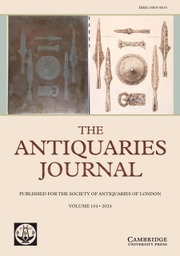No CrossRef data available.
Article contents
County Durham. By Martin Roberts, Nikolaus Pevsner and Elizabeth Williamson. 220mm. Pp xx + 880, 125 col ills, 64 figs, 11 maps. The Buildings of England series. Yale University Press, New Haven and London, 2021. isbn 9780300225044. £45 (hbk).
Review products
County Durham. By Martin Roberts, Nikolaus Pevsner and Elizabeth Williamson. 220mm. Pp xx + 880, 125 col ills, 64 figs, 11 maps. The Buildings of England series. Yale University Press, New Haven and London, 2021. isbn 9780300225044. £45 (hbk).
Published online by Cambridge University Press: 14 January 2025
Abstract
An abstract is not available for this content so a preview has been provided. Please use the Get access link above for information on how to access this content.
- Type
- Reviews
- Information
- Copyright
- © The Author(s), 2025. Published by Cambridge University Press on behalf of The Society of Antiquaries of London


